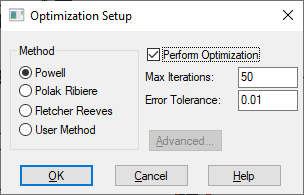
Global optimization is almost always a nonlinear problem and rarely is there a single best method for minimizing the cost function. You can choose from three optimization methods: Powell, Polak-Ribiere, and Fletcher Reeves. You can alternatively write a custom optimizer.
Regardless of the method you select, Embed produces a sequence of parameter updates on a per-run basis that decreases the value of the cost function. The basic parameter update equation is:
Pk+1 = Pk + rPk Ξ iteration index or Embed run number

The difference between each method is the way 
 is generated. For more information on these
methods, see numerical
recipes.
is generated. For more information on these
methods, see numerical
recipes.
To perform global optimization
1. Choose System > Optimization Properties.
2. In the Optimization Properties dialog box, activate the Perform Optimization option; choose the method you want and click OK; then start the simulation.

Error Tolerance: Indicates the maximum error between the results of two successive iterations. The default value is 10.
Fletcher Reeves: Specifies a conjugate gradient algorithm that requires fewer iterations to convergence. This algorithm is slower than Powell’s method.
Polak Ribiere: Specifies a conjugate gradient algorithm that is a bit more sophisticated than Fletcher Reeves for arriving at the supposed minimum of the quadratic form.
Powell: Specifies a direction-set algorithm that typically runs faster because it does not explicitly calculate the gradient.
User Method: Uses a user-written global optimizer named VOPT32.DLL to solve the equation.
Max Iteration Count: Indicates the maximum number of iterations.
Perform Optimization: This option must be activated to perform global optimization.